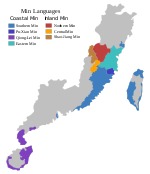Sanming dialect
Appearance
| Sanming | |
|---|---|
| 三明事 | |
| Pronunciation | [sɔ̃ ˥˥˧ mã˦˩ ʃia˧] |
| Native to | Southern China |
| Region | Sanming, Fujian |
Early forms | |
| Language codes | |
| ISO 639-3 | – |
| Glottolog | None |
| Linguasphere | 79-AAA-hbb |
The Sanming dialect (Central Min: 三明事, Mandarin Chinese: 三明話) is a dialect of Central Min spoken in urban areas of Sanming, a prefecture-level city in Western Fujian Province, China.
Phonology
[edit]The Sanming dialect has 18 initials, 37 rimes and 6 tones.
Initials
[edit]| Bilabial | Alveolar | Postalveolar | Velar | ||
|---|---|---|---|---|---|
| Nasal | m | n | ŋ | ||
| Stop | Tenuis | p | t | k | |
| Aspirated | pʰ | tʰ | kʰ | ||
| Affricate | Tenuis | ts | tʃ | ||
| Aspirated | tsʰ | tʃʰ | |||
| Fricative | s | ʃ | x | ||
| Glide | l | ||||
- Initials /m, ŋ/ may also be heard as prenasal [mb, ŋɡ] in free variation. When the two initials are followed by non-nasalized rimes, they can be heard as voiced plosives [b, ɡ].
- Palato-alveolar sounds /tʃ, tʃʰ, ʃ/ can also be heard as alveolo-palatal sounds [tɕ, tɕʰ, ɕ] in free variation among speakers.
Rimes
[edit]| Open syllable | Nasal coda | Nasal vowel coda | ||
|---|---|---|---|---|
| Open mouth | ɹ̩ ɛ ɒ a ɯ ø | aɯ au | am aiŋ m̩ | ã ɔ̃ |
| Even mouth | i iɛ iɒ ia iɯ | iau | iam iaiŋ | iã iɔ̃ ɛ̃ |
| Closed mouth | u uɛ ui o | ŋ̍ | uã | |
| Round mouth | y yi yɛ yo | yaiŋ | yã yɛ̃ | |
Tones
[edit]| No. | 1 | 2 | 3 | 4 | 5 | 6 |
|---|---|---|---|---|---|---|
| Tone name | dark level 陰平 |
light level 陽平 |
dark rising 陰上 |
light rising 陽上 |
departing 去聲 |
entering 入聲 |
| Tone contour | ˥˥˧ 553 | ˦˩ 41 | ˨˩ 21 | ˨˩˧ 213 | ˧ 33 | ˩˨ 12 |
The entering tones in the Sanming dialect do not have any entering tone coda (入聲韻尾) such as /-ʔ/, /-p̚/, /-t̚/ and /-k̚/. This feature is quite different from many other Chinese dialects.
Notes
[edit]References
[edit]- ^ Mei, Tsu-lin (1970), "Tones and prosody in Middle Chinese and the origin of the rising tone", Harvard Journal of Asiatic Studies, 30: 86–110, doi:10.2307/2718766, JSTOR 2718766
- ^ Pulleyblank, Edwin G. (1984), Middle Chinese: A study in Historical Phonology, Vancouver: University of British Columbia Press, p. 3, ISBN 978-0-7748-0192-8
- ^ Hammarström, Harald; Forkel, Robert; Haspelmath, Martin; Bank, Sebastian (2023-07-10). "Glottolog 4.8 - Min". Glottolog. Leipzig: Max Planck Institute for Evolutionary Anthropology. doi:10.5281/zenodo.7398962. Archived from the original on 2023-10-13. Retrieved 2023-10-13.
- Compilation Commission of Chorography of Sanming City 福建省三明市地方志编纂委员会 (2002). San ming shi zhi 三明市志 ["Chorography of Sanming City"]. Vol. 53. Beijing: Fangzhi chubanshe 方志出版社 ["Chorography Press"]. ISBN 978-7-80122-619-8.
- 吳, 瑞文 (Rui-Wen Wu) (2013). On the Grammatical Functions and Grammaticalization of tʰe5 in the Sanming Dialect [論三明方言tʰe5的語法功能及其語法化]. Language and Linguistics [語言暨語言學].

